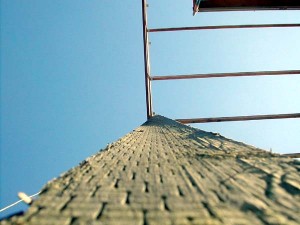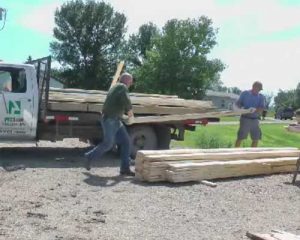Twisting Out of Control
This morning I received a voice mail message from a builder. He has arrived at a pole building jobsite where the materials have been “on the ground” for some time. It is now August, in Central Washington – where temperatures over 100 and humidity of next to nothing are not unusual. Not surprisingly, the builder reports some of the poles have experienced doing the lumber twist!
I’ve previously written about lumber twisting: https://www.hansenpolebuildings.com/2013/12/lumber-twist/ and https://www.hansenpolebuildings.com/2011/09/do-the-lumber-twist/
Twisting of lumber is something which can and will happen, but can be minimized. It is among the allowable defects of lumber: https://www.hansenpolebuildings.com/2013/12/lumber-defects/
 Although a fair amount of twist is allowable in pole building columns which have a four inch or smaller dimension (think 4×6), for members where both dimensions are five inches or greater – the amount of allowable twist within grade is not limited!
Although a fair amount of twist is allowable in pole building columns which have a four inch or smaller dimension (think 4×6), for members where both dimensions are five inches or greater – the amount of allowable twist within grade is not limited!
When I was still building, even though a timber might still be within grade at time of delivery to the building site, I always made it a practice to reject any timbers which I knew were so twisted as to make them impossible to work with. The great majority of lumber vendors will gladly take care of this, provided it is caught at time of delivery and the rejected timbers are sent back on the delivery truck right then. In most cases – if delivery is accepted, you own them!
Pressure treated lumber has had waterborne chemicals induced into the wood, under pressure. After treating, the moisture content of the wood can be as much as 200% of its weight. Lumber is particularly susceptible to twisting while curing (while drying out). The best way to minimize or eliminate twisting issues is to incorporate the treated columns into the building as quickly as possible. In the event prompt use is not possible, the timbers should be kept bound tightly.
Lumber units typically arrive with strong steel or plastic bands around them. These are rarely adequate to maintain the dimensional stability of timbers. Tight chains or cable restraints around bundles of timbers at frequent intervals, tightened as the material dries, may help to reduce the probability of twists. However even these measures may not be adequate to prevent twisting.
Indoor (or at least under roof) storage is ideal, but not always practical on a construction site.
Air flow is the most important factor in outside lumber storage. Allow large volumes air to circulate freely around stacked lumber in order to evaporate moisture from the lumber. Provide an open storage area with no trees or buildings blocking air flow. Remove weeds, grasses and other vegetation around lumber.
Good water drainage in storage area is important, as standing water adds to humidity.
When lumber is stacked on stickers (aka dunnage), place stickers in perfect vertical alignment with one another. Otherwise, sagging will occur.
In any case, before being incorporated into the building, keep pressure treated materials stored off the ground, on a flat surface, and protected from moisture and direct sunlight. Don’t get caught having to undo the lumber twist!
 Instead, spiral grain is the expected pattern – where the term describes the helical orientation of tree fibers which gives a log a twisted appearance after the bark has been removed. The twisted appearance is even more highlighted by surface checks, which follow the grain fiber, making the spiral grain very obvious in some standing dead trees and on utility poles and posts.
Instead, spiral grain is the expected pattern – where the term describes the helical orientation of tree fibers which gives a log a twisted appearance after the bark has been removed. The twisted appearance is even more highlighted by surface checks, which follow the grain fiber, making the spiral grain very obvious in some standing dead trees and on utility poles and posts.





